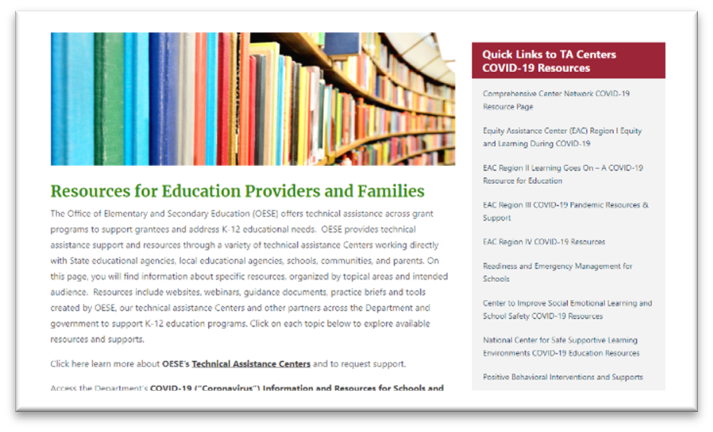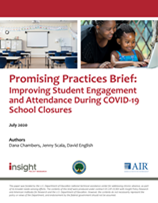
January 2021, Volume 2, Issue 4
Office of Elementary and Secondary Education (OESE)
Office of State Grant and Program Support Newsletter

From the Deputy Assistant Secretary
Letter From Ruth Ryder, Deputy Assistant Secretary for the Office of State Grant and Program Support

Dear Partners and Stakeholders:
It is the start of a new year, and with the start of every new year we look toward what lies ahead. For all of us, 2020 was a year of challenges, and the start of 2021 does not erase those challenges. But 2021 also begins with promise: new vaccines to help curb this pandemic and a new stimulus bill to support schools, communities, and families struggling with the impact of the pandemic.
Looking back at the challenges of 2020, we saw many accomplishments by my staff to meet the needs of our grantees and stakeholders. OESE released several waiver opportunities, guidance documents, and FAQs in response to questions and needs related to continuity of learning during the pandemic. In addition, we developed an OESE resource page that provides a one-stop shop of resources developed by our grantees, arranged by topic area. Finally, we launched the OESE Per Pupil Expenditure (PPE) website with an interactive map for the public to look at PPE data at district and state levels. These are only a few of the many things we accomplished in 2020.
On Dec. 27, 2020, President Trump signed into law the Coronavirus Response and Relief Supplemental Appropriations Act, 2021 (CRRSA), which provides an additional $54.3 billion for an Elementary and Secondary School Emergency Relief (ESSER) Fund (ESSER II). As you know, last spring the U.S. Department of Education (the Department) awarded more than $13 billion in assistance to elementary and secondary schools through the original ESSER Fund authorized by the Coronavirus Aid, Recovery, and Economic Security (CARES) Act. The new ESSER II funding intends to help states and school districts safely reopen schools, measure and effectively address significant learning loss, and take other actions to mitigate the impact of COVID‑19 on the students and families who depend on our K-12 schools. We look forward to working with you to ensure appropriate and productive use of these funds!
Looking forward to 2021, the Office of State Grant and Program Support (OSPGS) will continue to respond to the needs of our grantees and stakeholders by listening to you and responding to your needs. As noted above, we will support the efforts around the ESSER II and Governor’s Emergency Education Relief Fund II funds. Finally, OSGPS is working with our colleagues throughout OESE and the Department to develop sessions for the February National Association of ESEA State Program Administrators meeting. I hope to see many of you there virtually!
All the best for the better year ahead!
Ruth Ryder
|

Featured TA Center: Center to Improve Social and Emotional Learning and School Safety

The purpose of the Center to Improve Social and Emotional Learning and School Safety (CISELSS) is to provide technical assistance to support states and districts in the implementation of evidence-based social and emotional learning programs and practices. Its charge from the Department is twofold: (1) to build the knowledge and capacity of state educational agencies (SEAs) to support their local educational agencies (LEAs), and (2) for LEAs to support their schools.
In its first six months, the Center engaged in a needs-sensing effort that included interviews, surveys, and small group conversations with researchers, service providers, and practitioners, to gain a better understanding of the most urgent and important needs of the field. The Center published a brief that summarized five key themes that emerged from these conversations, which in turn guided the focus areas for the Center. These five themes are equity, integration, alignment and coherence, data-driven cycles of improvement, and sustainable implementation.
The Center is currently working with approximately 10 states in peer-to-peer collaboratives and has served several others through collaborations with other federally funded centers, such as the Comprehensive Center Network and the Regional Educational Laboratories.
The Center developed several practitioner-focused articles, tools, and videos that have been well received. Examples include:
The Center can be contacted using the Contact Us submission form or at selcenter@wested.org.
|

Meet Department Staff Member Francisco Ramirez
Learn more about Francisco Ramirez, an employee of the Department who works closely with CISELSS.
How long have you been at the Department?
- I joined the Department in December 2004 and started with what was then known as the Academic Improvement and Teacher Quality group. I worked on the Native Hawaiian Education and the 21st Century Community Learning Centers programs.
What do you most enjoy about working at the Department?
- I enjoy the fact that the work that we do directly supports students, teachers, and schools. While we may seem to be a few levels removed from those stakeholders, I know our work and effort make a difference in the lives of our students.
What did you do before coming to the Department?
- My community college was a grant recipient under Upward Bound (UB) and, later, the Educational Talent Search (ETS) program. I initially worked as an advisor for UB while I finished my undergraduate degree and, after I graduated, I became the coordinator for ETS.
What is one thing you’d like to see happen for this TA Center in the next year?
I would love to continue to work to ensure that teachers, schools, and districts have the resources on hand to support their students. The ongoing collaborations with other federally funded centers make it possible for schools and districts to access countless resources, but we must also work to make those resources accessible.
|

Technical Assistance Resources - New Year, New Opportunities

Updates on Waivers from the Department
On Dec. 1, 2020, the Department announced additional flexibility under the Student Support and Academic Enrichment Grant Program (Title IV, Part A) in response to the continued disruption to learning caused by COVID-19. States were asked to submit requests to the program mailbox at OESE.Title.IV-A@ed.gov. As of Jan. 4, the Title IV-A team has received a total of 17 waiver requests from states, which it anticipates approving shortly. If you have any questions, please feel free to contact Bryan.Williams@ed.gov.
On Sept. 18, 2020, due to the extraordinary circumstances created by the COVID-19 pandemic, the Department invited waivers of the requirement that a 21st Century Community Learning Center program operate “during nonschool hours or periods when school is not in session (such as before and after school or during summer recess).” This will support the hybrid education approach in which students are in school part of the week and participating in remote learning during other times. As of Jan. 4, the Department has approved 40 states for this waiver and is reviewing requests from three additional states. More information is available here.
On Jan. 4, the Department released Fact Sheet: State-Administered Programs Under the ESEA and the Nationwide Waiver From the U.S. Department of Agriculture to Allow Meal Pattern Flexibility in the Summer Food Service Program and the National School Lunch Program Seamless Summer Option Through June 2021. This resource provides information about the impact of U.S. Department of Agriculture waivers related to school meals programs on several Department of Education programs. It also provides information on options for states that currently use data from the National School Lunch program, such as data for districts to make school-level Title I allocations.
|

New Resources for Education Providers and Families
The OESE webpage, Resources for Education Providers and Families, recently added new resources to each topical page. Explore the six topical resource collections that highlight resources for families, educators, and school, district, and state leaders: Continuity of Learning, Learning at Home, Safe School Environments, Social Emotional and Behavioral Support, Supporting Special Populations, and Returning to School.
|


Tracking the Utility and Usefulness of ESSA Per Pupil Expenditure Data and District Pilot Opportunity
The National Center, in collaboration with the Edunomics LAB, developed this state data tracker for SEAs to create meaningful displays of school-by-school per pupil spending data that comply with ESSA’s financial transparency requirements as well as other benchmarks to ensure data are complete and useful to improve education. Education leaders, policymakers, parents, and advocates can use these financial data to make allocation decisions and improve schooling in their communities.
To support schools in this effort, the National Center is offering approximately 10 LEAs the opportunity to receive support from national subject matter experts in visualizing these data and using them for local policy conversations to inform education improvements in their communities. More information about this opportunity and how to apply can be found on the Comprehensive Center Network website.
|

Peer to Peer (P2P) Network
The National Student Attendance, Engagement, and Success Center launched an Attendance Peer-to-Peer (P2P) Network in November 2020, to support SEAs and LEAs coping with attendance and engagement challenges during the 2020-21 school year. This P2P supports teams representing eight states as well as selected partner districts, focusing on two topical strands — attendance data and attendance supports. As part of this work, the Center is providing support to enhance state attendance policies during hybrid and remote learning models. If you would like to learn more or find out how you can be involved please reach out to Dana Chambers (dchambers@insightpolicyresearch.org) or Jenny Scala (jscala@air.org).
|

What's New From the Institute of Education Sciences

Regional Education Laboratory Resource
Regional Education Laboratory (REL) Northeast & Islands has developed a free online course for teachers on developing, scoring, and using high-quality performance assessments within a balanced assessment system. Instructional leaders and administrators will also find the course’s sections on assessment literacy, data use, and balanced assessment systems to be valuable. The course can supplement teacher preparation program courses on classroom assessment.
|

Check in With Impact Aid

Impact Aid FY 2022 Application Deadline Reminder and H.R. 8472 – Impact Aid Coronavirus Relief Act
Does your district apply for Impact Aid Funding?
The deadline to submit applications for FY 2022 Section 7002 (payments for federal property) and Section 7003 (payments for federally connected children) is Feb. 1. Visit the Impact Aid Portal at https://impactaid.ed.gov/ to get started right away, using our helpful instructions, tips, videos, and resource documents.
On Friday, Dec. 4, 2020 the President signed H.R. 8472, the Impact Aid Coronavirus Relief Act (the Act). For FY 2022, the Act permits Section 7003 applicants the flexibility to use student count data from their reviewed prior year application, or apply as usual, using student count data from the 2020-2021 school year. Section 7002 LEAs may submit the same reviewed application data used on the FY 2021 application, or apply as usual.
Instructions for taking advantage of this new option, including how to find a copy of your LEA’s FY 2021 application, are available below:
The Sec. 7003 User Guide explains which portions of the application are subject to the new flexibility.
Review our Announcements page for the most up-to-date information during the application window. Start now to avoid the 10% penalty applied to applications submitted after Feb. 1!
Need Help?
If you need assistance, you can submit questions from inside the application system, phone our Help Desk at 202-260-3858, or send an email to Impact.Aid@ed.gov.
|

Office of Migrant Education News

H.R. 8472 Impacts the Title I Part C – Migrant Education Program
On Dec. 4, 2020, the President signed into law H.R. 8472, the “Impact Aid Coronavirus Relief Act.” This Act directs the Secretary of Education to use Migrant Education Program (MEP) child count data from school year 2018-19 or 2019-20, whichever data are greater, to determine Title I, Part C MEP award amounts for fiscal year 2021 and any subsequent year in which 2019-20 child count data would have otherwise been required to be used by law.
In order for the Secretary to determine whether the 2018-19 or 2019-20 migratory child count data are greater for each state, it is imperative that states follow the established process for reporting timely and accurate 2019-20 migratory child count data to the Department, i.e., the EDFacts and Consolidated State Performance Report (CSPR) data due in February 2021. If you have any questions about the impact of H.R. 8472 or the data reporting process, please do not hesitate to contact your state MEP Director.
|

FY 2021 Notice Inviting Applications for HEP and CAMP Grant Competitions Published in Federal Register
The Notice Inviting Applications (NIAs) for the 2021 High School Equivalency Program (HEP) and College Assistance Migrant Program (CAMP) competitions was published in the Federal Register on Nov. 23, 2020. The application period is open for 60 days, until Jan. 22. Competitive five-year grants for HEP and CAMP projects are made to institutions of higher education (IHEs) or to nonprofit private agencies that cooperate with such institutions. HEP helps migratory and seasonal farmworkers (or children of such workers) who are 16 years of age or older and not currently enrolled in school to obtain the equivalent of a high school diploma and, subsequently, to gain employment or begin postsecondary education or training. CAMP assists students who are migratory or seasonal farmworkers (or children of such workers) enrolled in their first year of undergraduate studies at an IHE. The funding supports completion of the first year of studies.
You may view the final HEP and CAMP NIAs through these links:
Applications for New Awards; High School Equivalency Program
![]()
About the Author
Ruth Ryder is the Deputy Assistant Secretary for the Office of Office of State Grant and Program Support in the Office of Elementary and Secondary Education (OESE) at the U.S. Department of Education. In this role, Ms. Ryder oversees a broad range of management, policy, and program functions related to formula and discretionary grant programs under the Elementary and Secondary Education Act, as amended by the Every Student Succeeds Act (ESEA). Ms. Ryder was previously the deputy director of the Office of Special Education Programs in the Office of Special Education and Rehabilitative Services, which she joined in 1988. Prior to joining the Department, Ms. Ryder was a program administrator in a Washington state school district. There she had responsibility for the Elementary and Secondary Education Act Title 1 and Title II programs, state-remediation, gifted education, outcome-based education, and state- and district-wide testing programs. Ms. Ryder has a bachelor’s degree in psychology and elementary education and a master’s degree in special education.
Read next
News From Others
Stakeholder Groups Urge Caution Regarding AI Use
Legislation
House Subcommittee Moves FY 2026 Labor-HHS-ED Bill Forward
USED & White House
DOJ Releases Guidance on DEI
| |



















